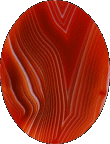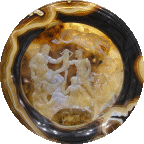| |
Sardonyx
|
Sard is an historical name for deeply reddish-brown chalcedony. It is named after Sardus, the capital of the ancient kingdom of Lydia in modern Turkey. The name had fallen out of favor with modern lapidaries because it almost completely overlaps with carnelian. The distinction between the two stones was often left to the individual lapidary to discern, causing the same stone to be categorized as a carnelian by one lapidary but a sard by the another.
Most of the early lapidaries also tended to use sard and sardonyx interchangeably, as is evidenced by their physical description of the stone. Sardonyx is much more distinct category. It is a banded agate that displays shades of red or black, interspaced with bands of white. Though some writers like Mandeville subdivided our modern sardonyx by calling the red and white versions sard, and the black and white sardonyx, this was not a universal concept.
It should be noted that these materials are all very closely related chalcedony. Depending on how it is cut a single rock might yield individual cabochons that are mottled red or banded red and white, while others were banded black and white. This means that it is both possible and likely that a single specimen would have parts that could be individually classified as carnelian, sard, or sardonyx. Indeed, the Romans believed that a stone possessing the red, black, and white bands were the most desirable manifestation of sardonyx.
The red or orange variety was instilled with the ability to stop hemorrhaging, and interrupt a woman’s menstrual cycle.
All verities were believed to counteract the negative properties of the onyx, dispel melancholy, make the wearer humble and pious, and to banish witchcraft and misfortune. It is ironic that the only gem historically accredited with the ability to quill bad behavior and cast off negativity is not the onyx or hematite as is often claimed today, but the little known sardonyx.
|
Colors
|
Shades of red, black, and/or white, Blotched or Banded
|
Locations
|
Sardonyx occurs worldwide.
|
Compisition
|
SiO2, semipellucid crystallized quartz silicate
|
Hardness
|
6
|
|

|

|

|
|
|
|
|
|